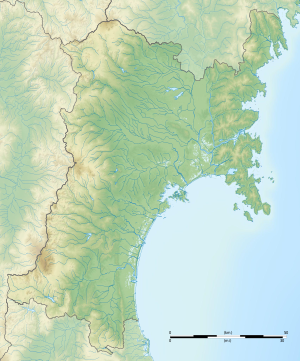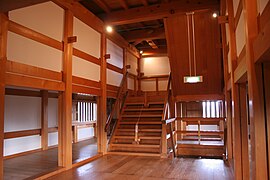Shiroishi Castle
| Shiroishi Castle | ||
|---|---|---|
|
Shiroishi Castle |
||
| Creation time : | before 1600 | |
| Castle type : | Hirayamajiro (hill castle) | |
| Conservation status: | Partly reconstructed | |
| Place: | Shiroishi | |
| Geographical location | 38 ° 0 '9.3 " N , 140 ° 37' 1.7" E | |
|
|
||
The Castle Shiroishi ( Japanese 白石城 , Shiroishi-jō ) is located in the town of Shiroishi , Miyagi Prefecture . In the Edo period , the katakura resided there. They were the elders of the Date clan and had an income of 13,000 koku , as much as a smaller daimyo .
The attachment
Shiroishi Castle was originally the residence of the Shiroishi, vassals of Date , but then came under the rule of Kamō Ujisato, who ruled Aizu Wakamatsu in 1591, who carried out a major expansion. During the Battle of Sekigahara Date Masamune conquered the castle and gave it in 1602 as a secondary seat to his important vassal Katakura Kagetsuna ( 片 倉 景 綱 ; 1557-1615) with an income of 13,000 Koku. The castle escaped the "One Province, One Castle" decree ( 一 国 一 城 令 , Ikkoku -ichijō-rei ) and held its status as a castle under eleven generations of the Katakura until the Meiji Restoration . During the Boshin War , the Katakura joined the Ō-U-Etsu Alliance ( 奥 羽 越 列 藩 同盟 , Ō-U-Etsu reppan dōmei ), but gave up their resistance together with the Date in Sendai.
The castle is located on a hill on the Shiroishi River. In essence, it consisted of the inner castle ( 本 丸 , hommaru ) and the Ni-no-maru ( 二 ノ 丸 ). In the west the Numa-no-maru ( 沼 ノ 丸 ) followed, in the south the Naka-no-maru ( 中 ノ 丸 ). The complex was protected by dry trenches and earth walls. The San-no-Maru ( 三 ノ 丸 ), which was protected by a moat, was located in the eastern part of the river . The samurai's apartments were located there.
The inner castle was surrounded by a stone wall and had a three-story watchtower ( 三階 櫓 , sangai yagura ) at the northwest corner , which acted as a castle tower ( 天 守 閣 , tenshukaku ). The Tatsumi watchtower was on the southeast corner and the Hitsujisaru watchtower. There was the residence ( 御 殿 , goten ). Access to this area in the north was protected by a double gate system, consisting of the Ōte-ichi-no-gomon ( 大 手 一 ノ 御 門 ) and the Ōte-ni-no-gomon ( 大 手 二 ノ 御 門 ), which protected a box-shaped protective area had an unusual system between them.
After 1868 the castle was abandoned, but after over a hundred years some replicas were completed in 1995. They include the three-story watchtower, the two gates mentioned. There are also gates that were removed from the city's temples, Tōshin-ji ( 当 信 寺 ) and Emmei-ji ( 延命 寺 ), when they were demolished during the Meiji period .
photos
Remarks
- ↑ Tatsu-mi ( 辰 巳 ) and Hitsuji-saru ( 未 申 ) are the corresponding intermediate directions within the framework of the Twelve Earth Branches .
- ↑ On the right the statue of the sumo wrestler Ōzutsu Man'emon (1869–1918) from Shiroishi.
literature
- Mizoguchi, Masafumi: Shiroishi-jo. In: Masayuki Miura (ed.): Shiro to jinya. Saikoku-hen. Gakken, 2006, ISBN 4-05-604379-5 .






